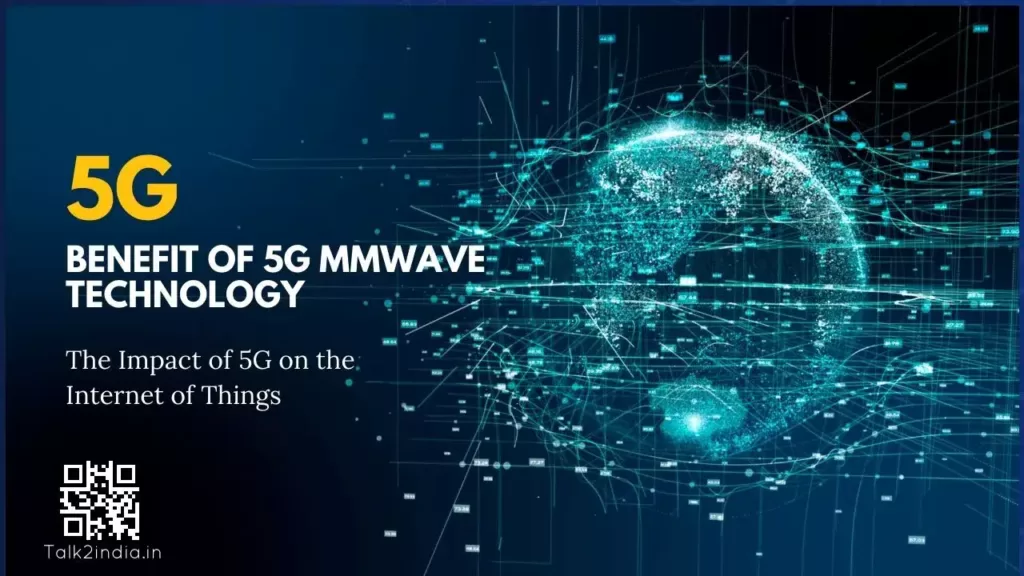What Is 5g Technology? How Does 5g Technology Enhance The Internet Of Things

5G is the fifth generation of mobile networks. 5G technology is the next generation of wireless networks, following 1G, 2G and 3G. 5G is a new type of wireless network that connects virtually everything, including machines and objects. New user experiences are possible thanks to improved performance and efficiency.
5G operates on the same radio frequencies as your smartphone, Wi-Fi networks, and satellite communications. However, it allows technology to go further.
5G allows you to download full-length HD movies to your phone in just seconds, even from a packed stadium. It’s about connecting everything everywhere, reliably and without lag, so that people can understand, measure, and manage things in real-time.
This is a huge opportunity – together we can take it to the next stage.
What Is A Benefit Of 5g Mmwave Technology?
Some might wonder why 5G requires mmWave, and why mmWave implies a higher network speed. Two main Benefit Of 5g mmWave Technology are: high bandwidth and plentiful spectrum resources.
High bandwidth
The millimeter-wave frequency band has a higher bandwidth than sub-6GHz. A wider bandwidth can support a higher speed. Let’s take trucking as an example. Data transmission is similar to the transport of goods between two points. Data must be transmitted to the goods in the truck. We use electromagnetic waves to travel the road between the beginning and ending points.
To quickly get all the goods from one end to the other, we can increase the lanes. This will allow us to increase the truck capacity, which in turn increases the bandwidth. More trucks can travel through a given lanes in a given time, so the number of lanes is greater. The bandwidth is the amount of data that can be received per unit time. This results in both a faster network speed and lower latency.
Also Read: How to Enable 5G in Jio
Rich resources
The frequency of the electromagnetic waves used in wireless communication technology is increasing from generation 1 to 5 as it develops. With many wireless communication services competing for the sub-6GHz frequency band, it is already very crowded. Below 6GHz, the spectrum resources available are becoming increasingly limited. In order to achieve a faster network speed, 5g needs to explore more frequency resources.
In contrast, the spectrum resource of mmWave is very rich and the frequency range that can be assigned to operators is extremely wide. The spectrum resources available are more richer if the frequency is higher than the frequency. The higher the spectrum resources, and the greater the transfer rate that can then be achieved, the more efficient it is. This is how the ultra-fast and high-capacity 5G network uses mmWave.
The Impact of 5G on the Internet of Things
According to some reports according to reports, 5G will offer 10 times faster than what speed is available in LTE networks. This speed will enhance the capability for IoT gadgets to communicate and transmit data quickly. For instance in the case of smart home appliances, this increase in speed will help reduce and increase overall speed when connected devices transmit or receive notifications, data and other information. Apart from Smart home appliances, nearly every IoT devices will gain speedily from this, which includes those that are used for industrial and health-related applications. How does 5g technology enhance the internet of things iot Let’s See.
5G and IoT Technology
Transmission technology is an integral role in Internet of Things (IoT) technology. It is the reason why the new 5G communication technology vital to IoT. 5G is expected to improve the speed of device connections more efficient and lessen delay.
5G is divided as three frequencies: low medium high and medium. Mid-bandwidth offers more connectivity than 4G over close distances, which allows an enhanced mobile broadband connection as well as more efficient machine-to machine communication. Thus there are thousands of IoT devices can utilize 5G within a limited space without putting a strain on the infrastructure. As the speed of data for the devices increase and the accuracy of the devices is also increasing thanks to machine learning. As consequently, IoT devices work faster and their reliability capabilities are growing every day.
Improving the autonomy of industrial processes through 5G connectivity is among the biggest opportunities to be considered for IoT devices. The rendering services of the first generation was followed by third and second generation, which offered voice and messaging along with internet connectivity, and then forth generation (4G also known as Long-Term Evolution (LTE)) had video streaming capabilities.
In 2023, the fifth generation of (5G) mobile communications is expected to be able to reach the world. The capabilities offered through 5G technologies is unquestionably thrilling, however the implementation isn’t without its challenges and dangers.
IoT Challenges in 5G
5g technology enhance the internet of things but The major challenges associated with 5G and IoT innovations are:
Spectrum availability and frequency bands
5G networks require frequencies that go up to 300GHz to provide speeds. This is 20 times faster than 4G LTE networks.
Coverage for deployment
High frequencies permit higher precision in radio wave that are capable of beam-forming. 5G antennas need to be located at a shorter distance to accommodate large quantities of data and users. The majority of basic antennas and channels are likely to be reduced during the 5G era. But, cities will still need to set up additional multipliers in order to transmit the waves and expand their length while maintaining constant speeds in the densest areas.
The scarcity of 5G devices
limitations of 5G phones in comparison to other phones that are not 5G is a concern. The scheduling of 5G transmission is affected by how many devices are available that are comparatively few. Furthermore, many technical difficulties that involve multiple bands, usually at low and high levels make it difficult to design an effective front space. This can cause problems with radiation due to the powerful transmission of high-frequency bands. This can result in a negative impact on efficiency at higher bandwidths and data rates.
Radiation
Like all radiation waves 5G produces electromagnetic radiation. It is a concern that radiation can cause harm to humans and other living creatures. Furthermore, the increasing amount of transmitters or cell towers that are being built to be used for 5G will cause more the risk of exposure to radiation which will affect the most people ever.
Security and privacy
In an era of data-driven technology 5G IoT deployments will be able to withstand both the common and more complex security threats to online networks. Communication will improve with faster than ever data rates. Cloud-based applications and databases to become as tight as they can be to safeguard user privacy and data. Similar to that, customers will have to be aware of the data management systems they use. 5G isn’t going to be an easy transition at first, and issues are likely to arise as we begin to enter the new technology of communications.
But the benefits more than outweigh the drawbacks, because the 5G release will also signal the advent of autonomous vehicles and advanced cities, smart homes of the future and many more.
Industries that are currently poised to benefit through 5G IoT improvements comprise industrial Intelligence, smart cities, buildings smart-resources security and surveillance, retail, agriculture, as well as healthcare.
5G IoT Applications
There are a variety of IoT applications that are 5G-compatible like:
- There is a way to park your smart car in a garage and charge wirelessly by using your city’s grid when you work.
- You can remote summon the car to drive to the garage and to your office’s door.
- Rural farmers are able to keep track of livestock, crops, and machinery more efficiently through drones and sensor networks that are super-dense.
- Home users are able to fully embrace the COVID-driven work-from-home model that is expected to last through the disease as a brand new norm in the workplace. Furthermore, home users can maximize their power use and stream their preferred music from any location.
- Society could become more efficient and efficient. Smart cities can live up to their names, and citizens are able to expect customized streams of information tailored to their needs.
5G in India
The topic of auctions for spectrum in 5G has been in the air for quite a while in India in the past. While many countries across the world have started rolling out the 5G network, India is yet to even auction off the 5G spectrum or even the commercial rollout.
The Telecom Regulatory Authority of India (TRAI) has released its first guidelines for auctions of spectrum 5G and an approach that hasn’t been well received by the telcos. But now the ball is at the government’s feet and it is to be seen what changes it will make and also takes the opinions of telecos.
The Cellular Operators Association of India (COAI) which is an organization that represents telecom operators has expressed its displeasure in a clear and direct manner.
“Given the recent seminal reforms for the telecom sector announced by the Government of India, these recommendations are one step backward [rather] than forward towards building a Digitally Connected India,” the group stated in an announcement.
Disadvantages Of 5g
Although 5G technology has been being developed and tested to address every radio signal issue and challenge in the mobile world however due to a security issues and the absence of technological progress in the majority of the geographical regions, it is not perfect.
- Technology is still in the process of being developed and research into its potential is ongoing.
- The speed at which the technology is promising seems to be difficult to attain (in the near future, it may be) due to the lack of technological support that is available across the majority in the entire world.
- A lot of older devices will not be able to connect to support 5G. Therefore they all have to be replaced with new ones — a costly deal.
- The development of infrastructure requires a high cost.
- The privacy and security issue is not yet resolved.
Some Other Highlighted disadvantages of 5G
1. OBSTRUCTIONS CAN IMPACT CONNECTIVITY
2. INITIAL COSTS FOR ROLLOUT ARE HIGH
3. LIMITATIONS OF RURAL ACCESS
4. BATTERY DRAIN ON DEVICES
5. UPLOAD SPEEDS DON’T MATCH DOWNLOAD SPEEDS
6. DETRACTING FROM THE AESTHETICS
Features and Specifications of 5G
- Speed up to 10Gbps > 10 to 100x speed increase when compared to 4.5G networks
- 1-millisecond latency
- 1000x bandwidth per square meter
- A 100x increase in the number of connected devices for a space (compared to 4G LTE)
- 99.999% availability
- 100 100% coverage
- 90 percent reduction in energy consumption
- 10-year battery life for devices with low-power IoT
Conclusion Of 5g Technology
5G can sustainably fulfill the need of an increase in 1000-time traffic. 5G will offer users high-speed data access that is comparable to fiber in addition to a “zero” latency user experience. 5G is capable of connecting 100 million devices.





